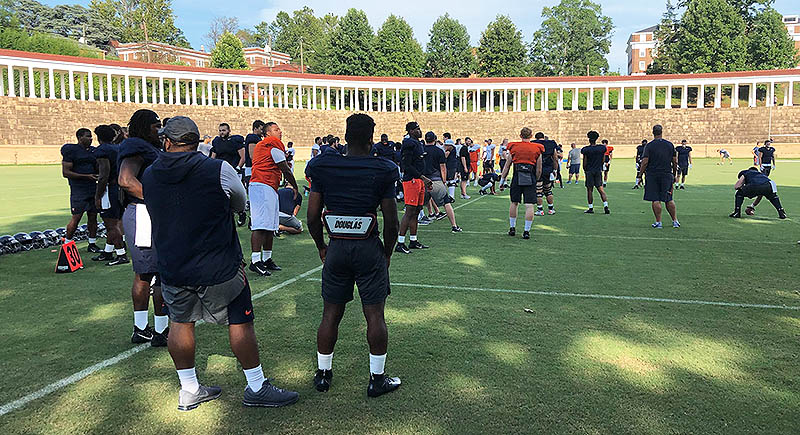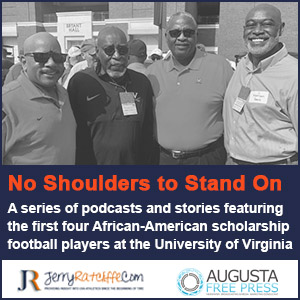Oh, If Lambeth Field Could Talk; The Stories It Could Tell…

More than 100 Virginia football players made the short trek from the McCue Center across the footbridge over Emmet Street, spilling into sacred ground at Lambeth Field on a toasty August afternoon Thursday.
Lambeth’s history goes unnoticed by today’s players. They know Virginia once played there, but that’s about it. Even most media attending the first 30 minutes of the practice had never been to Lambeth and knew nothing of the place.
UVa coach Bronco Mendenhall likes to conduct practice there once in awhile because it’s the only natural grass field available for the Cavaliers to use. The other two practice fields behind McCue are field turf.
Lambeth sits quietly just west of Rugby Road, its white pergola overlooking ancient concrete stands more than a century ago.
Oh, if this place could talk. The stories it could tell.
Football annals describe Lambeth Field as one of the greatest memorials to the inception of the game. Previously part of the Rugby Dairy Farm, work crews began to carve out an athletic field and stadium over the 21 acres in 1901. It opened a year later and was home to more than just football, but also baseball and track.
The football stadium was dedicated with a 34-0 victory over Vanderbilt in 1913 in a game referred to as “The Football Classic of the South.”
Once completed for that ‘13 season, Lambeth’s capacity was allegedly 8,000 fans, and a price tag of $35,000. Virginia, one of the South’s football powerhouses during this era, finished 7-1 that season, laying way for the 1914 and 1915 teams, some of the best teams in the nation.
Led by running back Eugene Nobel “Buck” Mayer of Norfolk, Virginia terrorized its opponents over those three seasons, compiling a 23-3-0 record while outscoring its collective foes 837-92. Mayer, the “South’s First All-American,” gave UVa fans something to get excited about.
Many football experts of the day believed that Virginia’s football program was one of the best in the nation, and laid claim to “Champions of the South,” on more than one occasion.
While Lambeth was the scene of many of those gridiron massacres, its history shined brighter for what changed the game and made it safer and more popular.
Because college football had grown so violent in those times, and players were dying or left disabled due to the physical nature of the game, legislators were strongly considering outlawing football, making it a crime to participate.
UVa president Edwin Alderman saved the game, not only in the state but around the nation, with the help of his “athletic director,” W.A. Lambeth, considering the father of the school’s athletic program.
Alderman delivered an impassioned speech to lawmakers and college football officials in a plea to save college football. He asked Lambeth to experiment with rules to make the game safer and Lambeth delivered, trying out various recommendations and ideas of his own on the same field where Virginia was practicing this past Thursday.
Before Lambeth’s experiment, college football was played with two halves, and the bigger, better teams, particularly offensively, would direct their attacks on the weakest players on the defense.
In those days, rules said that once a player was substituted, he could not return to the game. That would leave some players vulnerable to exhaustion and injury, particularly if offenses began to pummel them on every play.
Lambeth came up with the idea of giving players more time to rest by dividing the game into four quarters with a “breathing spell” between quarters and a longer halftime.
Lambeth also suggested that if a player left the game, he could reenter the next quarter. He also experimented with opening up the forward pass rule, which opened up the game and helped lead to its popularity today.
College football owes a lot to Mr. Lambeth, and Lambeth Field was his gridiron laboratory that saved the game and made it the action-packed game we all enjoy today.
One of my favorite days as a sportswriter came about 10 years ago when Dr. John Risher of Lynchburg, who was the oldest living Cavalier football player – a fact he often pooh-poohed – was approaching his 100th year of his life. He took me on a guided tour of Lambeth, where he watched games as a child and fell in love with football, a game he would eventually play for UVa.
He pointed out to me where President Calvin Coolidge and his wife, Grace, and entourage, watched Virginia’s Thanksgiving Day victory over rival North Carolina on Nov. 29, 1928.
There’s actually a lovely photograph of the Coolidges in my book: “The Virginia Football Vault,” a history of the Cavaliers, which has been added to the University of Virginia Library’s special collections, a fact I’m very proud about.
So, if you ever have the pleasure of taking in a practice or to just stroll around Lambeth Field, take a moment, breathe in the fresh air and the silence there. Sit in those ancient stands and try to appreciate what a shrine it should be to college football.








